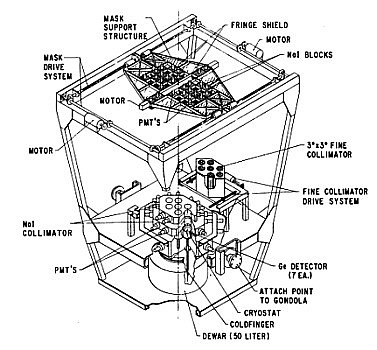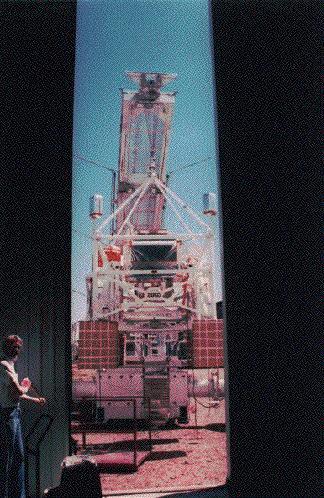Purpose of the flight and payload description
The GRIS instrument consists of an array of seven coaxial n-Type germanium detectors surrounded by a thick active NaI shield/collimator. Located above this assembly is an active NaI coded-aperture mask for imaging and precise source location. The seven germanium detectors are each enclosed in individual cryostats. This design (rather than a single large multi-detector cryostat) was chosen for two principal reasons: to minimize the internally produced background and for easier replacement of individual detectors, as well as upgrades and modifications.
The instrument is mounted in a gondola offering a conventional azimuth-over-elevation pointing system with a momentum wheel for azimuth control. Coarse pointing control used the earth's magnetic field as a reference. A CID camera was used to image star fields and the sun to obtain an independent and more accurate measure of the absolute pointing direction.
Details of the balloon flight
Balloon launched on: 9/23/1993 at 14:10 utc
Launch site: Scientific Flight Balloon Facility, Fort Sumner, (NM), US
Balloon launched by: National Scientific Balloon Facility (NSBF)
Balloon manufacturer/size/composition: Zero Pressure Balloon SF3-459.37-080-NSXCHR-ST
Balloon serial number: W39.57-3-03
Flight identification number: 370N
End of flight (L for landing time, W for last contact, otherwise termination time): 9/24/1993 at 14:25 utc
Balloon flight duration (F: time at float only, otherwise total flight time in d:days / h:hours or m:minutes - ): 24 h
Landing site: 5 miles SE of Hobart, Oklahoma, US
Observations of Cyg X-1, NGC 4151 and the Crab Nebula.
External references
- GRIS web site at Goddard Space Flight Center archive
- A balloon flight test of a coded-mask telescope with a multi-element germanium detector Nuclear Instruments and Methods in Physics Research Section A, v. 357, p. 580
- Great Moments in GRIStory at NASA's Goddard Space Flight Center website
- NASA Balloon Flights (1989-1998) in NASA Historical Data Book, Vol. VII: NASA Launch Systems, Space Transportation, Human Spaceflight, and Space Science, 1989-1998
617If you consider this website interesting or useful, you can help me to keep it up and running with a small donation to cover the operational costs. Just the equivalent of the price of a cup of coffee helps a lot.



